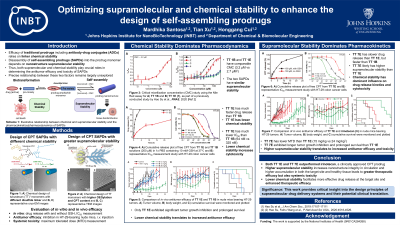Nanomedicine and Nanoscale Delivery (Focus Group - NND)
(394) Optimizing supramolecular and chemical stability to enhance the design of self-assembling prodrugs

Introduction: Prodrug design is a clinically successful drug delivery strategy. Traditional small-molecule prodrugs rely on linker chemical stability for bioconversion into the active drug. In contrast, self-assembling prodrugs (SAPDs) form supramolecular nanostructures that must first disassemble into their monomeric form—a process governed by supramolecular stability — before undergoing bioconversion. Both supramolecular and chemical stability play crucial roles in determining the antitumor efficacy and toxicity of SAPDs, but the precise relationship between these two factors remains largely unexplored.
Learning Objectives:
- Identify core design principles of self-assembling prodrugs and their clinical translation potential
- Explore how to tune supramolecular therapeutics by modifying supramolecular and chemical stability
- Analyze how supramolecular and chemical stability influence antitumor efficacy and systemic toxicity
Tian Xu – PhD Student, Chemical and Biomolecular Engineering, Johns Hopkins University; Honggang Cui – PI, Chemical and Biomolecular Engineering, Johns Hopkins University
.jpg)
Mardhika Santosa
PhD Student
Johns Hopkins University
Baltimore, Maryland, United States

